802 Light combo
$115.00 – Sold Out
| /
Lesson 3000 reel specifications:
- Weight: 320 grams
- Gear ratio: 5.2:1
- 10 ball bearings
- Carbontex washers
- Spooled with 200m of 3 kilo or 6 kilo colour change braid
- Comfortable good sized handle
Diawa Sweepfire spin 24A rod specifications:
- 8' 2-piece casting rod
- Rating: to 40 gram lures
- Weight: 170 grams
Package includes: Floats, split shot and two leaders including hooks
Delivery included in Australia
Collections: All products, Rod and Reel Combos
Category: Rod and Reel Combo
Type: Rod and Reel Combo
June 2017, half the year over already. And what a shocker it’s been, weather wise. Rain. Then, wind. More rain. And then, a cyclone. The effect has been fisho frustration with blokes unable to get wide or offshore for weeks on end. Here’s today’s forecast. 20 knots on Sunday, the most popular fishing day of the week:

There’s a factor at work recently making things even more frustrating. Seabreeze, Buoyweather and Willyweather give great forecasts. But of course they are based on isobars, barometers, cold fronts, high pressure systems and the like. They can’t take localized factors into consideration. Meaning that for instance, a local issue affecting weather doesn’t even show up on these online sites.
What’s been happening is that the weather sites forecast a five to ten knot westerly with a swell of under one metre, in the morning. You check that forecast online and plan a trip, launch the boat and progress down to the Heads. But as you come out into the open ocean there’s a nasty 15 knot westerly producing a short steep chop. The breaking crests get bigger the further east you go. You either keep going in a worsening sea, turn back and try something else, or just get frustrated.
It happened to us on Wednesday. Down to Roseville boat ramp, where Dan and Mev were waiting. Big day planned out wide with the jig combos prepped and multiple electric reels on board. An ominous sign that only two trailers were in a car park designed for 100+. But check this pic, taken as we cast off. Total glass out. We headed down the Harbour, with hopes high.
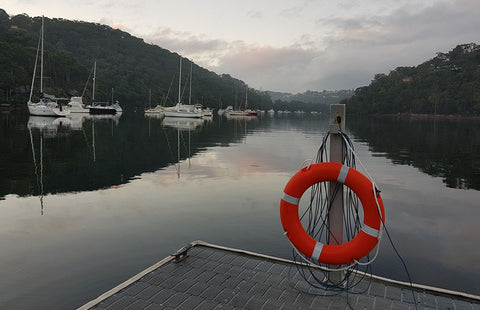
And those hopes crashed, as we passed South Head. White caps everywhere. Onto the Artificial Reef just two miles east. No-one else there. A brutal short chop. Drift really fast, even though we were in 3 metres of water. The obvious concern being how bad would the drift be in 400 metres, at Browns Mountain? If we could even get there, that is.
But we had a fallback. After having this happen too many times recently, I had added some of our $95 802 blackfish combos to the gear list. We originally imported these for carp fishing:
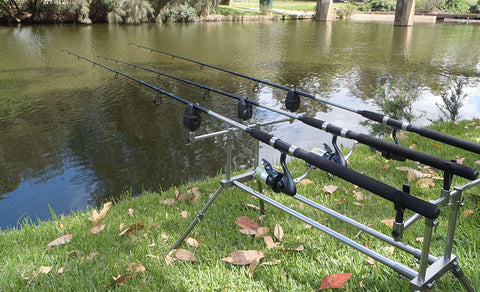
And they’ve been deadly, for that purpose:
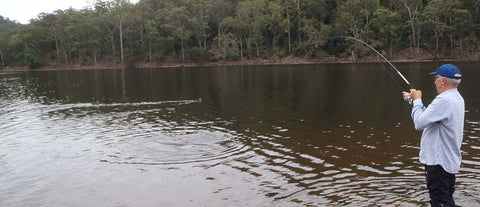
Here’s specs on the rod:
- Manufacturer: Daiwa
- Model: Sweepfire spin 24A
- Description: 8’ 2-piece casting rod
- Specification: Daiwa Sweepfire is an inexpensive quality rod ideal for light fishing where distance casting is required. Flathead on soft plastics, squidding, float fishing for blackfish, casting into salmon schools.
- Rating: to 40 gram lures
- Weight: 170 grams
- Packaging: Inside a cloth bag, secured in taped bubblewrap, shipped in cardboard carton.
The rod has a slow forgiving action, which soaks up the sudden sharp runs of hooked fish which so often cause a break off. We soon found it ideal for blackfish:
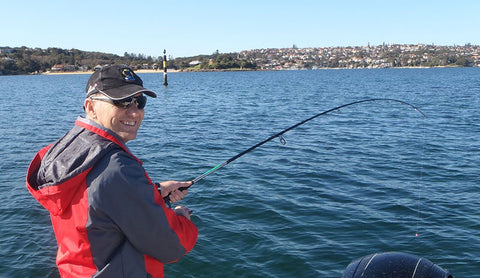
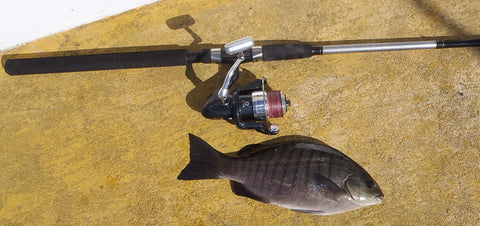
The reel is our proven Lesson 3000:
- Weight: 320 grams
- Gear ratio: 5.2:1
- 10 ball bearings, giving super smooth winding
- Carbontex washers for a super smooth drag
- Spooled with 200m of 3 or 6 kilo colour change braid
- And an important feature which too often gets overlooked - a comfortable good size handle:
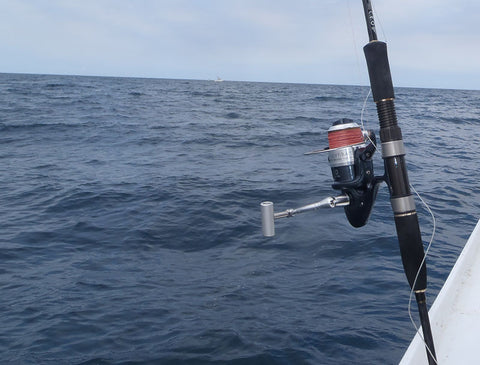
The rig is a plastic quill float held at the correct depth by a adjustable silicon stopper. Two tiny ball sinkers sliding on the braid, down to a micro swivel. Then a 70cm trace of 3 kilo fluoro carbon to a size 8 ringed Sneck hook – anodized in green finish, to match the weed colour.
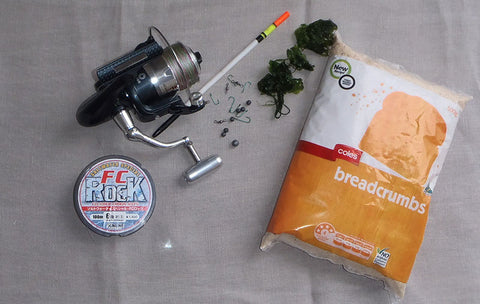
Up the Harbour, checking out mooring buoys for weed growth. These are in water too deep for the blackfish to venture, considering the risk from jewfish and sharks.
Scrape some into a plastic box and back we go to Sow & Pigs Reef. It’s a large area of shallow broken ground in lower Sydney Harbour, half way between Clifton Gardens, and Watsons Bay.
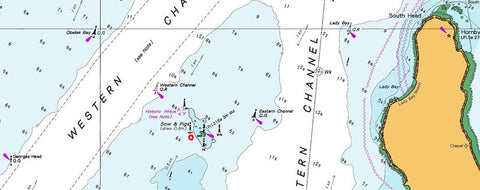
I’m told that rocky structures projected way above the water until the 19th Century, when they were used for naval gunnery targets.
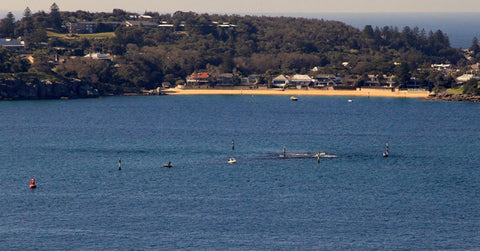
Runout tide coming down the Harbour with a westerly blowing, meaning everything was in alignment. We moor up with the reef anchor in 6 metres of water, 25 metres west on the Harbour Bridge side of the reef.
Dice up half of the collected weeds into small pieces, using a knife. Mix that with breadcrumbs and some saltwater in a bucket. Throw over small lumps regularly, and let the mix smell of fresh weed and breadcrumbs wash towards and hopefully eddy around the reef. Take one clean good quality cabbage leaf, from the weed box. Try and select a leaf with the tiny hard root still attached. Put the hook point through the middle of the leaf once, and then use the leader to make a hitch around the top of the root.
We were moored in six metres of water, with our baits set around three metres under the float. Normally that would be too far off the bottom but not in this case, due to three factors. The water was murky after recent rain. Heavily overcast so, low light levels. I figured those two factors would make the fish bolder than usual in following up the burley which sank very slowly and was maybe only two metres down, two or three rod lengths behind the boat. But the most important issue was that, at this spot, the Harbour floor gently rises to a couple of metres or less. So as the float and bait drifted towards the reef it would get closer to the bottom. Meaning all depths were covered.
A down is the word used when your float slides under the water as a blackfish nibbles at the bait. Dan got a down thirty seconds into his first drift. He counted to three slowly, lifted the rod tip, and felt the weight of a good fish – which unfortunately jumped off the hook almost immediately. But it was a very good start to the session. We then experienced a thirty minute quiet spell of few downs and a few missed strikes. As the tide picked up, and as the burley started to work its magic, the fish came on the bite.
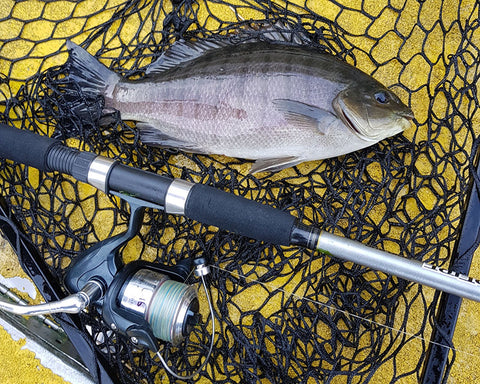
All were keepers, some approaching 40cm in length.
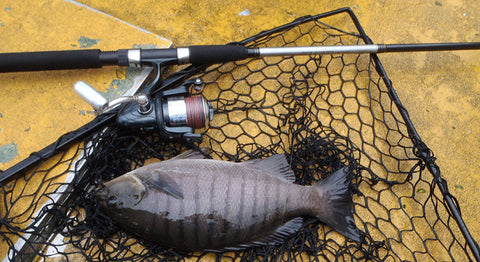
They fought hard, like they always do. Mev and Dan were happy to divide up the catch before taking their share home.
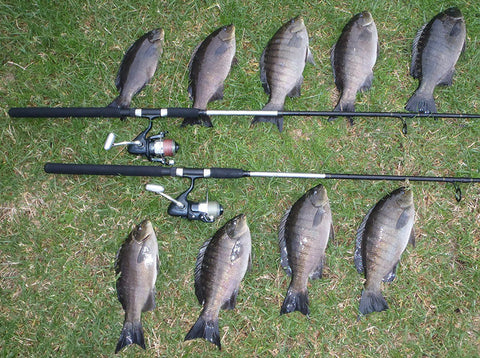
These fish taste great if a little extra bit of care is used in preparation. The best way to do that is firstly, keep the fish live until you get back to the boat ramp. A basic mesh keeper net will accomplish that. Secondly, after bleeding and gutting your catch, scrape the black lining from inside the stomach cavity. That can be done with the edge of a knife or with a small brush or even a toothbrush.
One last thing to mention? Twenty years ago, when I used to drive my boat under the Spit bridge and down through Middle Harbour, it was common to see two or even three small trawlers netting the dropoff in front of Castle Rock. A big part of their catch at the time was blackfish. But all those trawlers are gone now, and the Harbour is free of commercial fishing. After passing through the Heads, I would turn north or south to chase kingfish along the cliffs. The ledges would host dozens of blackfish anglers, almost all of which have gone now. Going even further back to the mid 1970s, my grandmother would drive me to Fairybower carpark in the morning – then pick me up in the afternoon, after a full days chasing blackfish off the rocks. On weekends, and even sometimes mid-week, there were so many anglers chasing blackfish that we would form a picket line. That’s when you bait up and cast in, and move right or left to follow the drift of your float. When you get to the end of your drift you wind in and go back to the start of the queue, which might have eight or ten anglers in it.
All that has gone now. Realistically, the pressure on this species has never been lighter since the 50s or even before. There are swarms of them in every suitable habitat both inside and outside east cost estuaries. They fight hard, they taste great, and you don’t need expensive gear to chase them. Yes, they are a challenge to catch, but the right gear makes that so much easier. The proof being this quality blackfish – the first he’s ever caught – for Mev on our boat, this week:
Give it a try.
As well as the rod, reel, and line I’ll throw in floats, split shot, and two leaders including hooks.
You’ll have everything you need to get started – except the green weed.
Thanks for reading, Andy
You may also like
Sign up to get the latest fishing reports, how to's and tackle news
© 2025 Downriggershop.
Powered by Shopify









